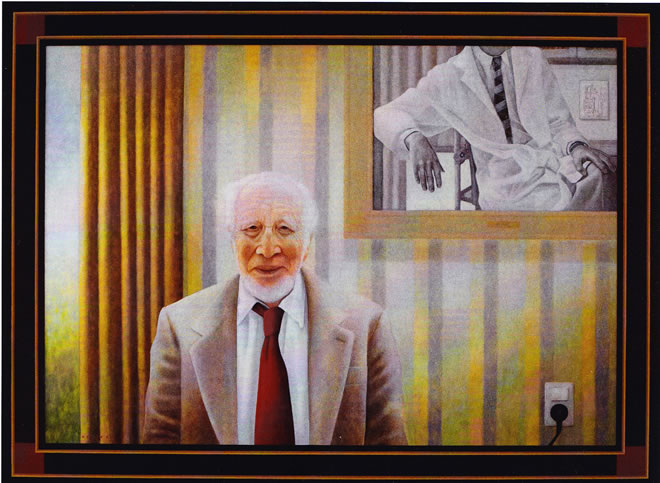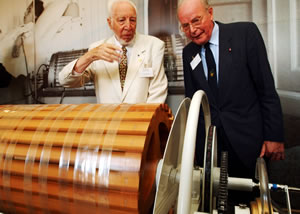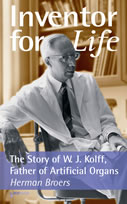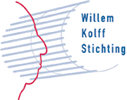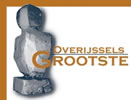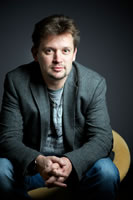Prof.dr. Willem Johan Kolff (1911-2009)
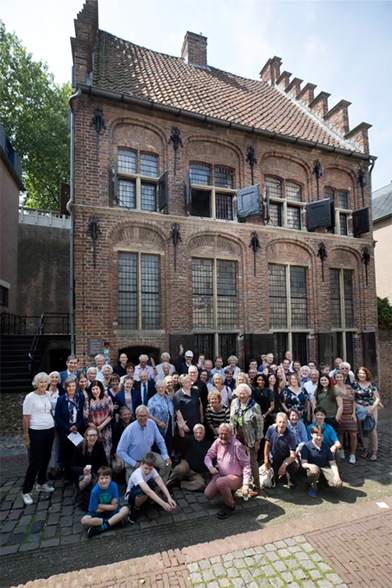
Prof.dr. Willem Johan Kolff, an honoured medic (C.O.N.), invented the articifial kidney, and more instruments
contribution by: Marius Kolff (CBCD XVIIw4)
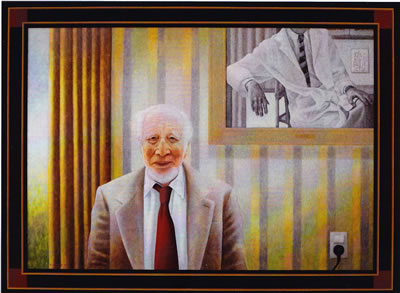 Prof. dr. Willem Johan (‘Pim’) Kolff is the inventor of the artificial kidney (1943) and the artificial hart (1956) and a pioneer in the field of numerous organ replacement therapies in the period 1943 – 1997. Worldwide he is considered to be the father of the artificial organs and as one of the most important inventors in the medical science. During his carreer he has recieved thirteen honorary doctorateships at universities all over the world and 127 international awards. Up to today his inventions have saved the lives of millions of people. Willem deceased on February 11, 2009, at Newtown Square (near Philadelphia, USA).
Prof. dr. Willem Johan (‘Pim’) Kolff is the inventor of the artificial kidney (1943) and the artificial hart (1956) and a pioneer in the field of numerous organ replacement therapies in the period 1943 – 1997. Worldwide he is considered to be the father of the artificial organs and as one of the most important inventors in the medical science. During his carreer he has recieved thirteen honorary doctorateships at universities all over the world and 127 international awards. Up to today his inventions have saved the lives of millions of people. Willem deceased on February 11, 2009, at Newtown Square (near Philadelphia, USA).
1911 – 1940
Willem Johan Kolff, nicknamed Pim, is born in a room in Hotel Rijnland at the Beestenmarkt in Leiden on February 14, 1911. He is the elder of five sons in a doctors family. He grows up in Hummelo (Achterhoek, Netherlands) and in Beekbergen (near Apeldoorn, Netherlands), where his father is the director of a sanatorium for tubercolosis patients. In the thirties Kolff studies at the medical faculty of the University of Leiden. He graduates in 1937. That same year he marries Janke Huidekoper and leaves for Groningen. At the University of Groningen he specializes in internal medicine. Being the youngest assistant in the internal medicine department he is coached by the Jewish professor Leo Polak Daniëls.
In 1938 Kolff experiences the death of one of his patients, a 22 years old farmers’ son from Groningen, because of a chronical kidney infection. Kolff starts to search for a treatment because he can not accept that kidney patients die simply because the cleaning funtion of their organs is not working properly.
1940 – 1950
On the day of the German invasion, May 19 1940, Kolff happened to be in The Hague attending a funeral. Seeing German bombers pass overhead, he made his excuses and went straight to the city’s main hospital, where casualties were already pouring in, and asked if they would like him to set up a blood bank. Provided with a car and an armed escort, he drove through the city’s streets, dodging sniper bullets, and bought bottles, tubes, needles, citrate and other paraphernalia. Four days later, at the Zuidwal Hospital at The Hague the first bloodbank in Europe was operational.
One month after the german occupation of the Netherlands professor Polak Daniëls and his wife commit suicide. This leaves a deep impact on Kolff. He decides to leave the Groningen academical hospital because he refuses to work with the successor, a National Socialist. Kolff is appointed internal medic on July 1, 1940, at the small town hospital of Kampen. Here he continues his kidney research. At that time a kidney problem is a deadly disease. When the blood is not cleaned any longer the patient dies a horrible death, because the debriss that accumulates in the body finds other ways out of the body than the usual way with the urine. Earlier research had been done for an artificial kidney, but up to then no invention was good enough for human use.
During the occupation years Kolff continues his research on the artificial kidney, apart from his work as an internal medic at the hospital in Kampen. He uses a practical approach and looks for easy to use and simple devices. Secretly he asks for the help of Henk Berk, director of the Kamper Emaille Fabrieken (Kampen Enamel Factories), who supplies enamel for parts of the artificial kidney. The local Ford dealer supplies him with the pump of a T-Ford which will be the engine for the kidney. End 1942 the first artificial kidney is ready for use and Kolff starts the treatment of patients. In the night of Wednesday March 17, 1943, he performs the very first hemodialysis on a patient: the cleaning of the blood, replacing the funtion of the kidneys, with a machine outside the body of the patient.
In Kampen Kolff becomes one of the leading figures of the local resistance. By simulating sickness with people who are about to be shipped away to Germany by the Germans, Kolff manages to keep many resistance people and jews out of the hands of the nazis. He manages to help 100s of Rotterdam men escape from labour work in Germany. Of the 10,500 people that were transported by ship through Kampen during these years, Kolff manages to select 1200 ‘ill’ people whom he accomodates in several emergency hospitals. In the end 800 of them manage to escape the Germans thanks to the help of Kolff and his fellow men in the resistance.
Not long after the liberation of the Netherlands, on September 11, 1945, the 17th patient treated with the artificial kidney is the first one with which the treatment has success. 67-Years old Maria Sofia Schafstadt, as it happens a member of the NSB (Dutch National Socialist movement, closely linked to the Nazis), is the first kidney patient in the world whose life is saved thanks to Kolff’s invention. On January 6, 1946, Kolff is gets his PhD at Groningen University on the subject of the artificial kidney.
The following years after the occupation time Kolff starts to develop a heart-lung machine that can take ovet these funtions when a patient is being operated on his heart. However in the after-war years in the Netherlands there are not sufficient funds for research.
1950 – 1997
For that reason the 39-years old Kolff decides, in the beginning of 1950 to move to the United States, with his wife Janke and five young children (Jacob, Adrie, Albert, Kees, and Therus). He obtains US-citizenship in 1955 and manages, succesfully, to continue the development of artificial organs. In 1956 the first heart-lung machine is marketed. With the use of this apparatus it becomes possible to operate a coronary. Also in 1956 he starts with his second work of life: the development of an artificial heart.
In 1967 he becomes professor at the University of Utah in Salt Lake City. Here he institutes a world famous laboratory for artificial organs which gives Salt Lake City the nickname ‘Biocon Valley’. From the sixtees and seventies the development of the artificial heart becomes better and better. In 1982 in Salt Lake City the first artificial heart is implanted with a human being. It gets international press attention. The patient, 61-year old dentist Barney Clark from Seattle manages to live for 112 days after which he dies of pneumonia.
Kolff’s active research on new and better artificial organs continued to 2005. Aged 93 Kolff was still working. Despite problems in hearing and with his sight he lectured all over the world till the end of 2006 and worked for at least five hours a day on improvements to artificial organs. The President of the Universioty of Utah once said: “Dr. Kolff will never stop working. In case his speed declines we will simply replace what is worn out by what has been developed by himself.” December 2006 Kolff retired for the third time (the first time had been 1986, the second 1997, but always he picked up from where he had stopped).
1997 – 2009
Kolff is considered to be the Father of the Articial Organs and with that has become one of the most important medical inventors of the 20th century. During his carreer he has recieved thirteen honorary doctorateships at universities all over the world and 127 international awards, amoungst which are the prestigious Japan Prize (1985), the Lasker Award (2002) and the Russ Award (2003). Four times he was nominated for the Nobel Prize, but did not get it. In 1970 he was awarded Commandeur in de Orde van Oranje Nassau (C.O.N.) and in 1985 he was included in the American Inventor’s Hall of Fame. In 1990 the American magazine ‘Life’ stated him as one of the 100 most important persons of the 20th century. In 2004 he got similar attention in the Netherlands: he ended 47 in the public (television) election of the ‘De Grootste Nederlander’, a list of the 100 most important figures in Dutch history, organized by De Telegraaf (newspaper), KRO (one of the public broadcasting associations) and the magazine Historisch Nieuwsblad. One year later he was elected de Grootste Overijsselaar (the Greatest Overijsel person) of all times.
The National Academy of Engineering, an organization of engineers in the United States – the one that awarded him in 2003 with the Russ Award, has calculated that since the invention of the artificial kidney in Kampen in 1943 more than 20 million people thank their lives to Kolff. Annually, all over the world, 100’s of thousands of people are being treated, which would not be possible without the work of Kolff.
Willem deceased on February 11, 2009, at Newtown Square (near Philadelphia, USA).
| Below is the image and the text of a card that was handed out to invitees on November 12, 2008. |
| It has been translated from Dutch to English by the webmaster (as were the other pages on Dr. Willem Kolff). |
The Kampen painter Wouter Berns (1970) got commisioned by the Stichting Vermogensbeheer Verenigde Gasthuizen to make a painting of inventor doctor Kolff (1911), on the occasion of the re-opening of the resotred part of the stadsziekenhuisgebouw as the main building of the care home of IJsselheem in 2005. Willem Kolff is the father of the artificial kidney and worked as internal medic in this building 1941-1950.
The portrait is an ’Ontmoeting met Dokter Kolff’ (Meeting with Doctor Kolff), aged 92, at the time visiting Holland from his new fatherland America, where he became world famous, back to the place where in 1941 his carreer started: the town hospital of Kampen in war times. Kolff has been placed up front, as if he comes to meet you. At the background a painting in a painting: Kolff during his glory years in America (1956- 1986). Here his hands are at the centre. The speaking and fluent hands, together with his aged head, are no doubt the result of a long and productive carreer. In the background is a charicature: this charicature was described by ir. J. Snoep, in the dark occupation years director of the machine factory De IJssel and illustrator. Snoep worked with Kolff and both were active in the local resistance agaiunst the German occupation forces. Snoep did not survive these years: he was taken by the Germans, suspected of resistance work, in 1944, and when he flied he got killed.
The very first kidney was driven by an engine from a sewing machine. Later inventions by Kolff (such as the heart-lung machine 1956, the artificial heart 1954) can hardly be described without any form of use of electricity. For that reason we see a socket in the painting. This symbolizes the technics that Kolff introduced in the medical profession.
Further, at left, a view into the future, symbolic for the visionaire Kolff is. Kolff who loved and knew a lot about 17th century Holland (the Netherlands). In the 17th century Dutch paintings views like this play an important role.
A copy of this painting was printed on a card, issued November 12, 2008, on the occasion of the opening of the Kolff Room as museum centre point of the former town hospital De Engelenbergstichting. The building is now the main building of the care centre IJsselheem at Kampen. Restauration and furnishing of the Kolff Room have been made possible by Stichting Vermogensbeheer Verenigde Gasthuizen, Vereniging TBC bestrijding Kampen and the Kolff Family Association.
Below is the text of a press release issued on the occasion of the opening of the Kolff Room (transl. by the webmaster).
KAMPEN (November 12, 2008) – On Wednesday November 12, 2008, 65 years after the first treatment with an artificial kidney of a patient, the former office of Prof. Dr. W.J. Kolff in the old Kampen town hospital (Stadsziekenhuisgebouw) was inaugurated as a museum room on Kolff and the artificial kidney. This renovated Kolff Room, an exposition, and a historical walking route are the foundations of a new touristic arrangement the Willem Kolff Stichting want to exploit as a medical-historic attraction.
In up keeping the former Stadsziekenhuisgebouw ‘De Engelenbergstichting’ as the main building of IJsselheem also the special past of this location remains accessible. Not just the unique design of the building (1913-1916, architect Willem Kromhout), but also the invention of the artificial kidney by Prof. Dr. Willem J. Kolff (1941-1950). As Martien van Goor, architect of the restaurations and new additions in 2003 stated: ‘With the building you keep the story alive’.
The Kolff Room was opened by Toos van Noordwijk, widow of the recently deceased assistant of Kolff, Bob van Noordwijk, and Jackie ten Hove, former chair of the Stichting tot Behoud van het Monumentale Ziekenhuisgebouw. Professor Kolff, now 97 years of age and living near the American city of Philadelphia, was not present due to his feeble health: he was represented by three of his five children.
If you want to take an interesting tour at Kampen on the theme Willem Kolff,
we advise you one of the ’Kolff Arrangements’ (new screen; Dutch language).
At this site see also De Colve IX (Szymborska on Kolff).
At other sites: check the links at right, and
Who is who in Overijssel (Dutch).
Gezamenlijk persbericht, maandag 25 mei 2009 - W.J. Kolff Institute, UMCG Groningen & Willem Kolff Stichting, Kampen
Naam medisch uitvinder Kolff keert na 68 jaar terug in UMCG:
Instituut voor Biomaterialenonderzoek BMSA Groningen wordt W.J. Kolff Institute
Bijna zeventig jaar nadat hij zijn carrière als medisch-technisch uitvinder daar begon, keert de naam van prof. dr. Willem Johan Kolff (1911-2009), vader van de kunstorganen, terug in Groningen. Het Instituut voor Biomaterialenonderzoek BMSA, onderdeel van het Universitair Medisch Centrum Groningen (UMCG), heet vanaf nu het W.J. Kolff Institute for Biomedical Engineering and Materials Science. Dit maken het UMCG en de Willem Kolff Stichting in Kampen hierbij gezamenlijk bekend. Het nieuwe W.J. Kolff Institute en de Willem Kolff Stichting organiseren op maandag 31 augustus 2009 gezamenlijk een groot internationaal symposium in Groningen ter ere van de naamgever die op 11 februari j.l. op 97-jarige leeftijd in de Verenigde Staten overleed.
Op dinsdag 1 september 2009, de dag na het Kolff Symposium in Groningen, wordt professor Kolff in de raadszaal van het stadhuis van Kampen officieel herdacht. Kampen is de stad waarvan Kolff sinds 1970 ereburger was wegens zijn mondiale betekenis voor de medische wetenschap. In aanwezigheid van nabestaanden zal aansluitend op deze bijeenkomst de as van Kolff worden uitgestrooid in de tuin van het voormalige Stadsziekenhuis in die stad, de plek waar Kolff tijdens de Tweede Wereldoorlog met de kunstnier zijn eerste successen behaalde.
Kolff ontwikkelde in het stadsziekenhuis van Kampen – waaraan hij van 1941 tot 1950 verbonden was als internist – de kunstmatige nier, voorloper van de hedendaagse nierdialyse. Dankzij de uitvinding van Kolff kunnen honderdduizenden nierpatiënten over de hele wereld in leven blijven. Kolff kwam naar Kampen vanuit Groningen, waar hij in de periode 1938-1940 als arts-assistent onder professor Leo Polak Daniëls, hoofd van de interne afdeling van het Academisch Ziekenhuis, zijn eerste experimentele onderzoekswerk naar een kunstmatige nier had gedaan. Kolff vertrok uit Groningen nadat de joodse Polak Daniëls tijdens de meidagen van 1940 zelfmoord had gepleegd.
Kolff ging in 1941 naar Kampen en zette daar zijn pionierswerk voort. Op 11 september 1945 redde hij er als eerste medicus ter wereld. De kunstnier van Kolff geldt als het begin van de mondiale biomedische techniek die in 65 jaar tijd verantwoordelijk was voor het redden of veraangenamen van 20 tot 30 miljoen mensenlevens. Kolff emigreerde in 1950 naar Amerika, waar hij gedurende 45 jaar vanuit eerst Cleveland (tot 1967) en later Salt Lake City (tot 1997) zou uitgroeien tot de belangrijkste pionier op dit gebied. Na zijn kunstnier (1942) was hij tevens uitvinder van het kunsthart (1957) en droeg hij significant bij aan de ontwikkeling van diverse andere kunstmatige organen en medisch-technische uitvindingen, waaronder de hart-longmachine, kunstmatig zien en kunstledematen. Kolff kreeg voor zijn pionierswerk 13 eredoctoraten en 127 internationale prijzen. een nierpatiënt het leven met zijn zelfgebouwde kunstmatige nier.
Directeur van het nieuwe W.J. Kolff Institute, prof. dr. ir. Henk Busscher, stelt trots te zijn dat zijn onderzoeksinstituut de naam Kolff mag dragen. ‘Professor Kolff is één van de grootste uitvinders en meest veelzijdige wetenschappers die Nederland in de twintigste eeuw heeft voortgebracht. Hij was de allergrootste op het gebied van biomedische techniek en hij heeft heel veel Nederlandse onderzoekers die door de jaren bij hem werkten gestimuleerd met zijn enthousiasme en zijn wijze van denken. De wortels van zijn carrière liggen hier in Groningen, dus het is in meer dan één opzicht mooi dat zijn naam terugkeert in deze stad.’ Busscher hoopt dat wetenschappers worden geïnspireerd en gestimuleerd door de naam van Kolff.
Het recht de naam Kolff te voeren, werd het BMSA namens de familie Kolff verleend door de Willem Kolff Stichting in Kampen. WKS-voorzitter dr. John Jacobze stelt verguld te zijn met het initiatief. ‘Hiermee blijft de naam Kolff behouden voor de actieve medische wetenschap. Groningen heeft als stad waar Kolff is begonnen, net als Kampen als stad waar Kolff voor het eerst succesvol was met zijn uitvindingen, een historisch recht om deze naam te hanteren. Groningen is bovendien een van de actiefste centra in Europa op het gebied van biomedische techniek.’ Willem Kolff Stichting en W.J. Kolff Institute gaan intensief samenwerken, het Kolff Memorial Symposium van 31 augustus is daarvan het begin. De Willem Kolff Stichting is en blijft gevestigd in Kampen, van waaruit ook in de toekomst zowel zelfstandig als gezamenlijk activiteiten georganiseerd zullen worden.
Op het Kolff Memorial Symposium 2009, op 31 augustus in de Blauwe Zaal van het UMCG in Groningen, staat verleden heden en toekomst van kunstorganen centraal onder het thema ‘Artificial Organs, 60 years and beyond’. Toonaangevende wetenschappers uit Europa en de Verenigde Staten zullen ter ere van hun overleden pionier lezingen geven en in discussie gaan over de vorderingen op hun vakgebied door de jaren heen.
Voor recente informatie over deze bijeenkomsten, ga naar:
www.willemkolffstichting.nl of op www.kolff-umcg.nl.
Een dag later, op 1 september, verplaatst een deel van het internationale gezelschap zich naar Kampen voor het bijwonen van de officiële herdenkingsceremonie in het stadhuis van Kampen. Aansluitend wordt in besloten kring de as van Kolff in Kampen verstrooid. Voor meer informatie, kijk op www.willemkolffstichting.nl
| De nieuwe Nederlandstalige biografie van Willem Johan is te verkrijgen via de website www.dokterkolff.nl | |
| Persberichten, 12 mei 2011 en 16 november 2011 – Willem Kolff Stichting |
16 november 2011
| Both press releases were issued in Dutch. |
Hernieuwde biografie en expositie kunstnieruitvinder in 100ste geboortejaar; Leven en werk ‘Dokter Kolff’ terug in de schijnwerpers
KNAW-president Robbert Dijkgraaf nomineerde hem in ‘De Wereld Draait Door’ voor de Nederlandse ‘Think Different’-lijst, geïnspireerd op Steve Jobs. In die lijst van dwarse denkers die de wereld veranderden, vertegenwoordigt hij de uitvinders: Willem Johan Kolff (1911-2009), uitvinder van de kunstnier (1942) en het kunsthart (1957). Kolff zou in 2011 honderd jaar geworden zijn, daarom verschijnt zaterdag 19 november opnieuw de enige Nederlandse biografie over deze medisch pionier aan wie miljoenen mensen hun leven te danken hebben: Dokter Kolff, kunstenaar in hart en nieren van auteur Herman Broers. Deze geactualiseerde en uitgebreide editie van het boek dat in 2003 voor het eerst verscheen, vertelt het fascinerende levensverhaal van deze gedreven wetenschapper, idealist en verzetsman. Tegelijk met verschijning van het boek opent in het Stedelijk Museum in Kampen een expositie over het pionierswerk van Kolff.
Over het boek
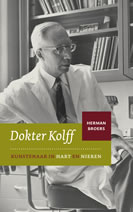 Arts en uitvinder Willem Johan Kolff (1911-2009) wordt mondiaal beschouwd als een van de belangrijkste medische pioniers van de twintigste eeuw. Met zijn kunstmatige nier, gemaakt van worstenvel, rubberslangen, een waterpomp van een T-Ford, aluminium uit een neergeschoten vliegtuig, een naaimachinemotor en een waterbak van een pannenbouwer, redde hij in oorlogstijd als eerste een nierpatiënt het leven. Miljoenen zouden volgen. Kolff bewees met zijn kunstnier (1942), een hart-longmachine (1956) en het kunsthart (1957) dat je organen bij mensen daadwerkelijk kunt vervangen door machines. Hij ontketende een revolutie in de medische wetenschap: techniek inzetten om mensenlevens te redden. Dokter Kolff, kunstenaar in hart en nieren reconstrueert het enerverende levensverhaal van deze boeiende pionier. Een spannende biografie van een arts, uitvinder, verzetsman en idealist die successen kende, maar ook grote offers bracht in zijn levenslange strijd om mensen op het randje van de dood terug te brengen naar een vreugdevol en menswaardig bestaan.
Arts en uitvinder Willem Johan Kolff (1911-2009) wordt mondiaal beschouwd als een van de belangrijkste medische pioniers van de twintigste eeuw. Met zijn kunstmatige nier, gemaakt van worstenvel, rubberslangen, een waterpomp van een T-Ford, aluminium uit een neergeschoten vliegtuig, een naaimachinemotor en een waterbak van een pannenbouwer, redde hij in oorlogstijd als eerste een nierpatiënt het leven. Miljoenen zouden volgen. Kolff bewees met zijn kunstnier (1942), een hart-longmachine (1956) en het kunsthart (1957) dat je organen bij mensen daadwerkelijk kunt vervangen door machines. Hij ontketende een revolutie in de medische wetenschap: techniek inzetten om mensenlevens te redden. Dokter Kolff, kunstenaar in hart en nieren reconstrueert het enerverende levensverhaal van deze boeiende pionier. Een spannende biografie van een arts, uitvinder, verzetsman en idealist die successen kende, maar ook grote offers bracht in zijn levenslange strijd om mensen op het randje van de dood terug te brengen naar een vreugdevol en menswaardig bestaan.
Herman Broers (1970) ontmoette Kolff voor het eerst in 1999 als verslaggever, toen de arts terug was in Nederland om het Stadsziekenhuisgebouw in Kampen voor sloop te behoeden. Broers besloot zich in het leven van Kolff te verdiepen. Hij zocht hem op in de VS, waar hij sinds 1950 woonde, interviewde familieleden, vrienden, collega’s, bewonderaars en critici. Zijn boek Dokter Kolff, kunstenaar in hart en nieren verscheen in 2003 bij Mets & Schilt (Amsterdam), in 2007 verscheen het als Inventor for Life in het Engels bij B&Vmedia. In 2010 schreef Broers het boek Blauw Haar, het mirakel van academiestad Kampen over de snelle opkomst en ondergang van het studentenklimaat in die stad in de jaren zeventig en tachtig van de vorige eeuw. Blauw Haar werd genomineerd voor Overijssels Boek van het Jaar 2010. Voor de nieuwe uitgave van Dokter Kolff reisde Broers in 2011 opnieuw naar de VS voor aanvullende research en interviews.
Over de presentatie en de expositie
In de Gouden Zaal van het Stedelijk Museum in Kampen zal auteur Herman Broers op zaterdag 19 november om 14.30 uur de eerste twee exemplaren aanbieden aan algemeen directeur van de Nierstichting Tom Oostrom en voorzitter van de Willem Kolff Stichting John Jacobze. Daarna opent Tom Oostrom de expositie Kolff Kunstnier Kampen in het museum. De expositie is tot 15 januari 2012 te zien.
12 mei 2011
Viering van het honderdste geboortejaar uitvinder kunstnier
WILLEM KOLFF STICHTING EN NIERSTICHTING OPENEN ‘KOLFF 100 JAAR’
Kampen/Bussum, 12 mei 2011 – De Willem Kolff Stichting en de Nierstichting hebben vanochtend in Bussum het symbolische startsein gegeven voor de viering van het honderdste geboortejaar van prof. dr. Willem Johan Kolff (1911-2009). Met zijn meest baanbrekende uitvinding – de kunstmatige nier uit 1942 – redde hij het leven van miljoenen nierpatiënten over de hele wereld. Een mijlpaal waaraan in 2011 veel aandacht wordt besteed tijdens tal van activiteiten, lezingen en een congres dat de Willem Kolff Stichting en Nierstichting dit jaar organiseren.
De vasthoudendheid, betrokkenheid en creativiteit van professor Kolff zijn al sinds de oprichting belangrijke drijfveren voor de Nierstichting. Om deze inspiratie tastbaar te maken, overhandigde John W. Jacobze – arts, oprichter en voorzitter van de Willem Kolff Stichting – een prachtig bronzen borstbeeld van Kolff aan Tom Oostrom, directeur van de Nierstichting. “Door dit beeld een plek te geven in het gebouw van de Nierstichting maken we een zichtbaar compliment aan de manier waarop de Nierstichting zich inzet voor nierpatiënten. Wij hopen dat Kolff een blijvende inspiratiebron is voor de medewerkers van de Nierstichting en iedereen die de Nierstichting steunt”, benadrukt Jacobze.
Tom Oostrom – algemeen directeur van de Nierstichting – sprake mede namens alle Nederlandse nierpatiënten zijn waardering uit voor dit bijzondere gebaar. “Het werk en de visie van Kolff zijn niet alleen voor de Nierstichting een grote inspiratiebron. Zijn gedrevenheid en kennis zijn van groot nut voor de jonge wetenschappers van vandaag. Door zijn lessen te hanteren, kunnen ze bijdragen aan oplossingen voor problemen die nierpatiënten nog altijd ondervinden.”
Willem Johan (Pim) Kolff werd 100 jaar geleden – op 14 februari 1911 – geboren in Leiden en stond aan de basis van een uitvinding die erg veel heeft betekend voor vele nierpatiënten wereldwijd. In een ziekenhuis in Kampen vond Kolff in 1942 de kunstnier uit, de voorloper van het huidige dialyseapparaat. Zijn uitvinding maakte het mogelijk de kleine, maar dodelijke hoeveelheid afvalstoffen uit het bloed van nierpatiënten te filteren. Dit maakte nierfalen van een dodelijke tot een voor velen behandelbare aandoening. Professor Kolff overleed in 2009. Hoewel hij vooral voortleeft als de uitvinder van de kunstnier werkte hij zijn hele leven aan allerlei andere kunstmatige organen. Zo ontwikkelde hij in 1957 tevens het eerste kunsthart ter wereld.
‘100 jaar Kolff’
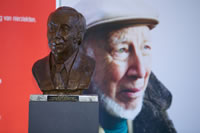
De Willem Kolff Stichting en de Nierstichting organiseren dit jaar gezamenlijk tal van activiteiten in het kader van 100 jaar Kolff. Zo staat op 29 en 30 september het nationale Kolff 100 Congres op het programma in de Leidse Schouwburg in Leiden, de geboortestad van Kolff. Op de eerste dag vindt op de Leidse universiteit een wetenschappelijke competitie plaats tussen teams van Nederlandse academisch medische centra en technische universiteiten. Tijdens de ‘Battle of the Universities’ strijden zij om het Van Noordwijk Stipendium, een geldbedrag van 10.000 euro. Deze wetenschappelijke prijs is vernoemd naar de belangrijkste assistent van professor Kolff, prof. dr. Jacobus van Noordwijk (1920-2008). Deze 20-jarige ondergedoken medisch student ontwikkelde met Kolff in het stadsziekenhuis van Kampen in de oorlog de eerste kunstmatige nier ter wereld. Tijdens de wetenschappelijke wedkamp staan de teams voor de uitdaging binnen 24 uur ‘in de geest van Kolff’ een oplossing te bedenken voor een medisch-technische casus. Zij presenteren deze oplossing de volgende dag tijdens het congres. Het winnende team wendt het stipendium aan om op de eigen universiteit de aanzet te geven voor het daadwerkelijk onderzoeken en implementeren van de oplossing die zij hebben bedacht. De tweede dag van het congres staat in het teken van de thema’s Herstel (stamceltherapie) en Ondersteunen (devices).
Replica kunstnier
Het leven en het werk van Kolff staan in 2011 centraal tijdens een expositie in het Stedelijk Museum in Kampen. Tijdens deze tentoonstelling wordt ook een bijzondere replica van de kunstnier getoond. De replica is gemaakt als de laatste van drie in een meerjarig educatief project voor jonge Amerikaanse studenten Biomedische Techniek. Zij bouwen aan het begin van hun opleiding een replica van een oorspronkelijke kunstnier om inzicht te krijgen in de basis van de medische technologie. Tevens worden ze hopelijk ‘besmet’ met de geestdrift en het pionierswerk van Kolffr. Een groep studenten van Temple University in Philadelphia werkt nu aan de derde en laatste kunstnier, de zogeheten twin-coil kidney van Baxter-Travenol uit 1953. Deze kunstnier zorgde samen met het kunstmatig bloedvat, de ‘shunt’, uit 1961 voor de definitieve doorbraak van dialyse als levensreddende behandeling voor miljoenen nierpatiënten over de hele wereld. In de zomer wordt deze replica van de Verenigde Staten naar Nederland verscheept.
Kolff Lezingen
De 14e eeuwse Gouden Zaal van het Stedelijk Museum in Kampen is op vier zaterdagmiddagen in november, december 2011 en januari 2012 het toneel van een reeks populair-wetenschappelijke en historische lezingen over aan Kolff gerelateerde thema’s. Variërend van het Kolff-kunsthart tot een baby-dialyser en Kolff in Kampen: het ziekenhuis, het verzet in de oorlog en de gevangenentransporten.
Naast alle activiteiten die in het komende jaar op de agenda staan wordt een volledig vernieuwde, geactualiseerde en uitgebreide versie van de uit 2003 stammende Kolff-biografie ‘Dokter Kolff, kunstenaar in hart en nieren’ van auteur Herman Broers in november 2011 uitgegeven.
‘Als de mens de werking van een orgaan kent, moet hij in staat zijn het te bouwen.’
– prof.dr. W.J. Kolff (1911 -2009) –
